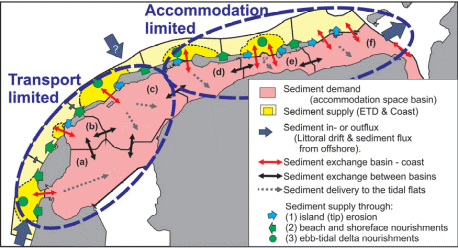Q.J. Lodder1, 2, Z.B. Wang2,3, G.Ramaekers1
1 Rijkswaterstaat,
2 Delft University of Technology, Faculty of Civil Engineering and Geosciences,
3 Deltares,
Introduction
Research on sediment transport in relation to coastal management along the Dutch coast has often focused on diffusion of sediments from nourishment locations. Often the research question bowls down to "how quickly do nourishments diffuse and need to be reinstalled?" or "can we optimize the nourishment strategy by reducing diffusion times". However, for the long-term morphological development of our coast limitations to the net sediment transport capacity might be a more important factor then diffusion times. In our poster presentation we will give examples of the importance of net sediment transport capacity limitation to coastal management.
Example: net sediment transport limitation at the Wadden Sea
Our research has shown that the net sediment transport capacity is a key driver for the development of the Wadden Sea (e.g. Wang, et al., 2018). The morphological development of the Western part of the Wadden Sea is already partly determined by the net sediment transport capacity of the tidal inlets (e.g. Marsdiep). Our analyses show that, under accelerated sea level rise, the net sediment transport capacity also becomes the critical factor determining the large scale development of other parts of the Wadden Sea (Lodder, et al., 2019). On centennial time scales it is likely that the net sediment transport capacity determines the morphological future of the Wadden Sea.
Example: diffusion of the Sand Motor
The Sand Motor was installed at the Delfland coast in 2011. Multiple authors have published on many aspects of the Sand Motor (e.g. Luijendijk & van Oudenhoven, EDS, 2019). One of the conclusions is that the Sand Motors diffusion is confined to a couple of kilometres to the north and south. The diffusion is as expected limited by the net sediment transport capacity. This highlights the challenges for long-term coastal management where nourishments are used to supply the coastline with the sediments it need to adapt to sea level rise. As a result of the limits to the net sediment transport capacity a distributed nourishment strategy is likely needed.
Example: stability of the multiple channel system of the Western Scheldt
At the Western Scheldt large scale dredging is needed for safe navigation to the Antwerp harbour. The dredged material is being placed at disposal sites in one of the two channels. The natural redistribution of the placed sediments is a net sediment transport limited process. Which might result in long-term instability of the two-channel system. Conservation of the two-channel system is an important objective of the management of this system. The net sediment transport capacity therefore has a direct influence on management of the estuary.

Figure 1 Schematic overview of transport limited and accommodation limited parts of the Wadden Sea (Wang et al., 2018)
I. Surname1*, F.N. Another-Surname2 , Y. Next-Surname2
1 University Name, Country; 2 Organization Name, Country
* Corresponding author: mail.name@organization.org


